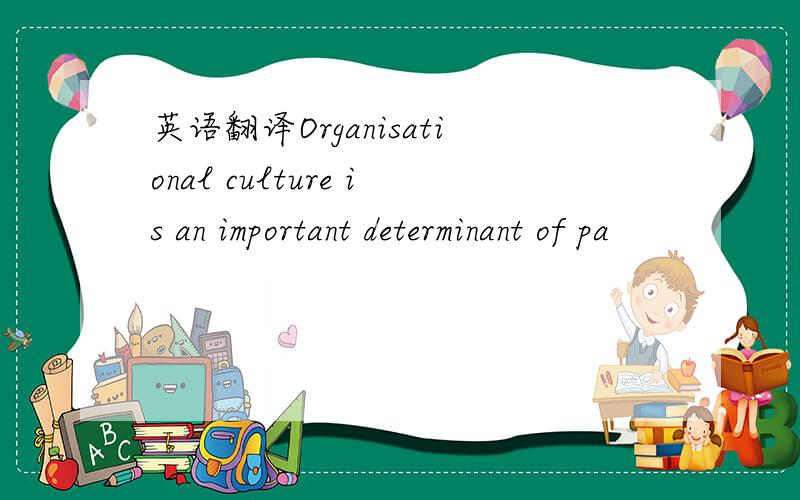英语翻译Organisational culture is an important determinant of pa
来源:学生作业帮 编辑:神马作文网作业帮 分类:英语作业 时间:2024/11/18 08:10:14
英语翻译
Organisational culture is an important determinant of patient safety in healthcare organisations.1–8 Research efforts in various countries have focussed on assessment safety culture.1–13 Dimensions of safety culture have been linked to several healthcare outcomes such as medication errors,nurse back injuries,urinary tract infections,patient satisfaction,patients' perceptions of nurse responsiveness and nurse satisfaction.9
Safety problems are believed to arise from safety violations and unintentional errors and mistakes.10 Studies show that the majority of errors and adverse events more accurately stem from a complex chain of events that jointly contribute to the cause rather than human errors.11 12 Efforts to minimize these injuries have led to the patient safety movement,and the generally accepted definition of patient safety is the prevention and reduction of adverse outcomes or injuries stemming from the processes of health care.13
Culture and climate are often used interchangeably and may represent different approaches to measurement of the same phenomenon.Organizational culture definitions are multiple and varied but generally characterise culture as the shared values,norms and tacit assumptions of members within an organization,while others include more tangible characteristics such as social practices and capacities in the definition.14 Safety climate is defined as shared perceptions regarding the events,practices and procedures as well as the kind of behavior that gets rewarded,supported and expected in a particular organisational setting.15
Characteristics of a strong and proactive safety culture are generally thought to include:leadership commitment to learning from errors,documenting and improving patient safety,encouraging and practicing teamwork,identification of potential hazards,using systems for reporting and analyzing adverse events and perceiving workers as key players in improving safety rather than causing errors.16 Safety culture is also characterised by systemic data collection and reporting,17 blame-free environment,leadership involvement18 and a focus on systems.19
Researchers have identified four factors from the literature that characterise a safety culture:(1) recognition of the risk of error in the organization’s activities,(2) blame-free environment for reporting,(3) collaboration across the organisation and (4) organisational resources for safety.20 An overall safety climate that encompasses the development of effective safety practices and encourages adherence to these practices as well as continuous learning from errors provides that basis for safer performance.
Organisational culture is an important determinant of patient safety in healthcare organisations.1–8 Research efforts in various countries have focussed on assessment safety culture.1–13 Dimensions of safety culture have been linked to several healthcare outcomes such as medication errors,nurse back injuries,urinary tract infections,patient satisfaction,patients' perceptions of nurse responsiveness and nurse satisfaction.9
Safety problems are believed to arise from safety violations and unintentional errors and mistakes.10 Studies show that the majority of errors and adverse events more accurately stem from a complex chain of events that jointly contribute to the cause rather than human errors.11 12 Efforts to minimize these injuries have led to the patient safety movement,and the generally accepted definition of patient safety is the prevention and reduction of adverse outcomes or injuries stemming from the processes of health care.13
Culture and climate are often used interchangeably and may represent different approaches to measurement of the same phenomenon.Organizational culture definitions are multiple and varied but generally characterise culture as the shared values,norms and tacit assumptions of members within an organization,while others include more tangible characteristics such as social practices and capacities in the definition.14 Safety climate is defined as shared perceptions regarding the events,practices and procedures as well as the kind of behavior that gets rewarded,supported and expected in a particular organisational setting.15
Characteristics of a strong and proactive safety culture are generally thought to include:leadership commitment to learning from errors,documenting and improving patient safety,encouraging and practicing teamwork,identification of potential hazards,using systems for reporting and analyzing adverse events and perceiving workers as key players in improving safety rather than causing errors.16 Safety culture is also characterised by systemic data collection and reporting,17 blame-free environment,leadership involvement18 and a focus on systems.19
Researchers have identified four factors from the literature that characterise a safety culture:(1) recognition of the risk of error in the organization’s activities,(2) blame-free environment for reporting,(3) collaboration across the organisation and (4) organisational resources for safety.20 An overall safety climate that encompasses the development of effective safety practices and encourages adherence to these practices as well as continuous learning from errors provides that basis for safer performance.

在医疗单位,组织文化是患者安全的一个很重要的决定性因素.
1–8很多国家都将研究重点放在患者安全文化的评估上.
1–13 患者安全文化的衡量可以与一些医疗结果挂钩,像用药错误, 护理背部外伤,尿路感染,患者满意度, 患者对护理责任感和满意感的看法.
9安全问题往往与安全违规和无心之错有关.
10研究表明大多数错误和问题时间,更精确的讲,都是由复杂的事件链共同造成的,而不仅仅是人为失误.
11 12在最大限度减少这些伤害方面的努力,已经使病人可以安全活动(Efforts to minimize these injuries have led to the patient safety movement,这句话的翻译我不大确定),同时,广为接受的关于患者安全的定义是预防和减少源于护理过程的负产出或伤害.
13文化和氛围这两个词经常可以交替使用,来代表衡量同一现象的不同方法.组织文化定义是多元的,但通常文化的特点是共同的价值观,规范和同组织成员的默许的假设,但其他的定义里可能还包括更多有形的特点,例如社会实践和能力.
14 安全氛围被定义为在一个特定的组织中,能被奖励、支持和预期的有关事件的共同看法,实践和过程.
15一个强大主动的安全文化的特点一般包括,从失误中学习的领导认同, 记录和提高患者安全,鼓励和实践团队精神, 潜在危险识别,使用系统来报告和分析问题事件,在提高安全时而不是造成失误后,把工作人员当成主导.
16 安全文化也有系统化的数据收集报告的特征
17免责环境,领导参与
18对系统的关注.
19研究者已经在文献中找到了四个可以描述安全文化的因素, (1)组织活动中失误的风险识别 (2) 报告的免责环境(3) 跨组织协作(4) 安全的组织资源
20一个整体的安全氛围包括提高和鼓励有效的安全实践,也包括不断的从失误中学习以期待更加安全的绩效表现.
希望对你有帮助!
1–8很多国家都将研究重点放在患者安全文化的评估上.
1–13 患者安全文化的衡量可以与一些医疗结果挂钩,像用药错误, 护理背部外伤,尿路感染,患者满意度, 患者对护理责任感和满意感的看法.
9安全问题往往与安全违规和无心之错有关.
10研究表明大多数错误和问题时间,更精确的讲,都是由复杂的事件链共同造成的,而不仅仅是人为失误.
11 12在最大限度减少这些伤害方面的努力,已经使病人可以安全活动(Efforts to minimize these injuries have led to the patient safety movement,这句话的翻译我不大确定),同时,广为接受的关于患者安全的定义是预防和减少源于护理过程的负产出或伤害.
13文化和氛围这两个词经常可以交替使用,来代表衡量同一现象的不同方法.组织文化定义是多元的,但通常文化的特点是共同的价值观,规范和同组织成员的默许的假设,但其他的定义里可能还包括更多有形的特点,例如社会实践和能力.
14 安全氛围被定义为在一个特定的组织中,能被奖励、支持和预期的有关事件的共同看法,实践和过程.
15一个强大主动的安全文化的特点一般包括,从失误中学习的领导认同, 记录和提高患者安全,鼓励和实践团队精神, 潜在危险识别,使用系统来报告和分析问题事件,在提高安全时而不是造成失误后,把工作人员当成主导.
16 安全文化也有系统化的数据收集报告的特征
17免责环境,领导参与
18对系统的关注.
19研究者已经在文献中找到了四个可以描述安全文化的因素, (1)组织活动中失误的风险识别 (2) 报告的免责环境(3) 跨组织协作(4) 安全的组织资源
20一个整体的安全氛围包括提高和鼓励有效的安全实践,也包括不断的从失误中学习以期待更加安全的绩效表现.
希望对你有帮助!
英语翻译Organisational culture is an important determinant of pa
英语翻译Language is an important part of culture,and becoming fa
英语翻译the organisational culture within a company differs grea
英语翻译language is part of culture and plays a very important r
Passage 12Packaging is an important form of advertising.A pa
What is one very important part of Native Amerrican culture?
英语翻译Informal conversation is an important part of any busine
英语翻译Doing homework is an important part of learning.Homework
英语翻译Community service is an important component of education
英语翻译Turkey is an important part of American traditional food
英语翻译Instill a culture of risk consciousness that respects an
英语翻译An important issue is the scope of application of theGAT